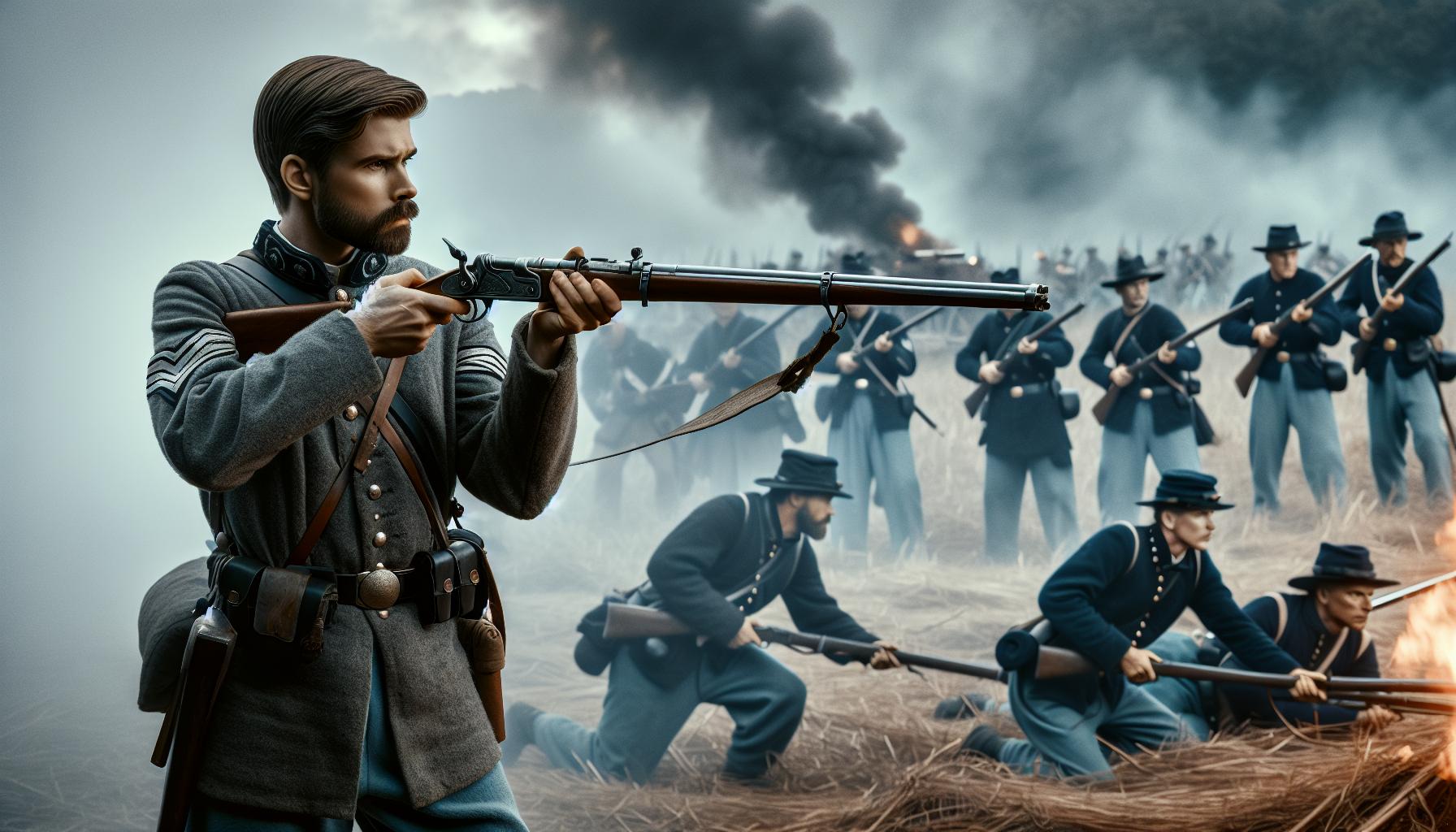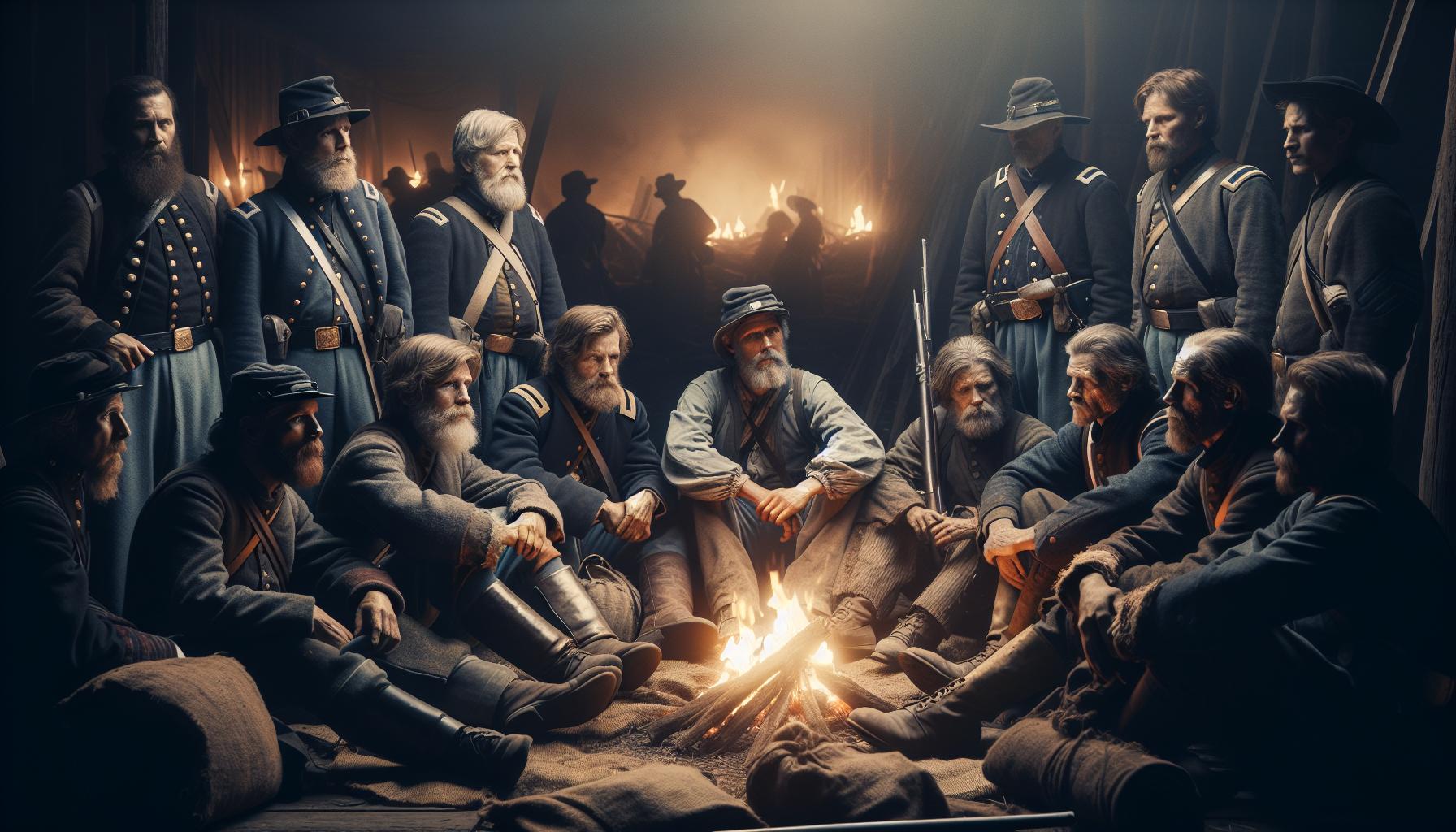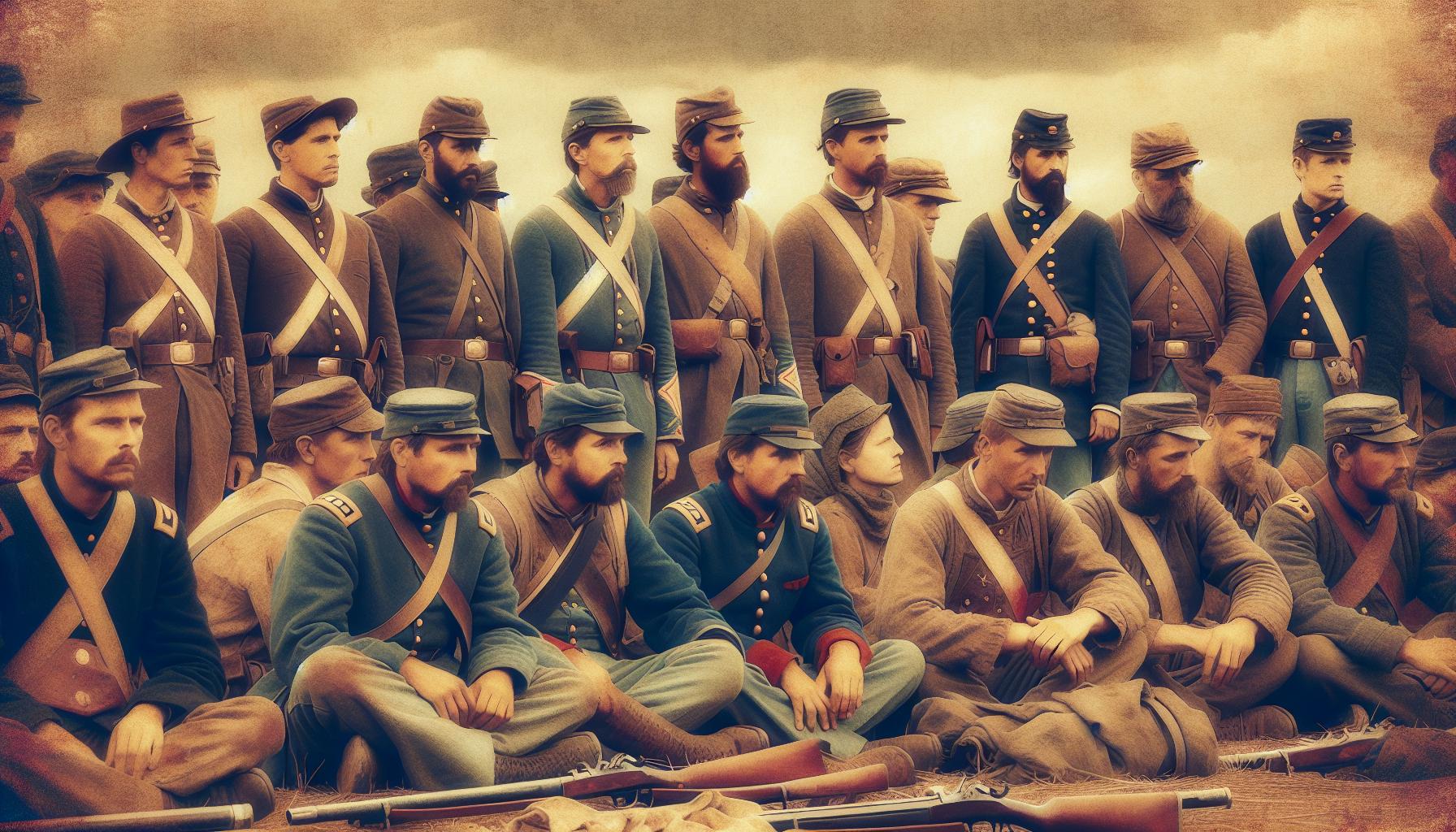Key Takeaways
- Cultural Representation: Civil War movies powerfully illustrate the complexities of a divided nation, making historical events relatable through personal stories and character experiences.
- Key Themes: Prominent themes include heroism, villainy, and sacrifice, which highlight the moral dilemmas faced during the war and its personal toll on individuals and families.
- Cinematic Techniques: Filmmakers employ color, lighting, and sound to enhance emotional engagement and authenticity, creating immersive experiences that resonate with audiences.
- Impact on Public Perception: These films shape contemporary views on race, equality, and the legacy of the Civil War, fostering discussions about morality and justice in today’s society.
- Significant Films: Noteworthy titles like Glory, Gettysburg, and 12 Years a Slave provide insights into the era’s complexities and contribute to critical historical discourse.
Civil War movies have a unique power to capture the complexities of a divided nation, showcasing the struggles of individuals caught in a tumultuous time. These films not only entertain but also provoke thought about morality, sacrifice, and the human experience during one of America’s darkest chapters. Through vivid storytelling and compelling characters, they breathe life into historical events, making them accessible and relatable to modern audiences.
Analyzing these films reveals deeper themes and cultural narratives that shape our understanding of the Civil War. From the portrayal of heroism and villainy to the nuanced depiction of social issues, each movie offers a lens through which viewers can explore the past. By delving into the artistic choices and historical contexts, one can uncover how these cinematic interpretations influence perceptions of the Civil War and its lasting impact on American society.
Civil War Movie Analysis
Civil War movies encompass a range of genres, including drama, action, and documentaries. These films illustrate the conflict’s socio-political dynamics and its personal toll on individuals and families. They often depict critical battles and significant events, offering audiences a glimpse into the struggles faced during this period.
Key themes in these films include:
- Heroism: Characters often represent the valor and bravery displayed in battle, while also showcasing the moral dilemmas faced by soldiers and civilians.
- Villainy: Depictions of antagonistic figures highlight the conflicts not only on the battlefield but also within society, emphasizing the moral complexities of the era.
- Sacrifice: Many narratives focus on the personal sacrifices made for greater causes, reflecting the harsh realities of war’s consequences.
Prominent films like Glory (1989), Gettysburg (1993), and 12 Years a Slave (2013) underscore these themes while presenting powerful visuals and scripts. These cinematic works contribute to historical discourse, ensuring that Civil War stories remain relevant and impactful.
Moreover, filmmakers often utilize various artistic choices, such as cinematography, music, and character development, to evoke emotions and deepen viewer engagement. Historical accuracy varies across films, yet many strive to depict the civil strife authentically, prompting discussions about the interpretations of historical narratives.
Overall, Civil War movies serve not only as entertainment but also as vital conduits for understanding the past, shaping modern perceptions of the Civil War and its lasting influence on American society.
Key Themes in Civil War Movies

Civil War movies explore crucial themes that reflect the complexities of the era. These films engage with historical events and personal stories, providing viewers with a deeper understanding of the past.
Representation of Historical Events
Civil War movies meticulously portray key historical events, emphasizing their significance. Films like Gettysburg focus on pivotal battles, capturing the strategic intricacies and human experiences involved. Authenticity in dialogue, costumes, and settings enhances historical representation, drawing viewers into the era. Documentaries such as The Civil War (1990) use archival footage and expert commentary to offer factual narratives, providing context to the struggles faced. Through dramatic reenactments, these films illustrate the socio-political dynamics of the time, highlighting themes of loyalty, betrayal, and the moral dilemmas individuals encountered. By juxtaposing personal stories with historical milestones, filmmakers invite audiences to reflect on the complexities of the Civil War’s impact.
Personal Narratives and Perspectives
Personal narratives in Civil War movies shed light on individual experiences amid widespread conflict. Films such as 12 Years a Slave reveal the harsh realities of slavery and the humanity stripped away by war. They portray characters grappling with loss, loyalty, and identity, providing intimate glimpses into their struggles. Perspectives vary greatly; from soldiers’ duties to civilians’ hardships, these films encapsulate the multifaceted nature of the era. By presenting diverse viewpoints, including those from marginalized groups, filmmakers enlarge the understanding of the war’s consequences. Emotional depth, driven by personal stories, fosters empathy and honest reflection on the legacies of the Civil War in contemporary society.
Cinematic Techniques in Civil War Films

Cinematic techniques play a crucial role in how Civil War films convey their messages and engage viewers. These techniques enhance the portrayal of historical events, emotions, and themes central to the narrative.
Use of Color and Lighting
Color and lighting significantly influence the mood and tone of Civil War films. Filmmakers often utilize a muted color palette to reflect the somber nature of the era, evoking feelings of despair and loss. For example, films like Gettysburg (1993) employ sepia tones and dim lighting to create authenticity, emphasizing the harsh realities faced by soldiers and civilians. Light sources such as natural sunlight or flickering fires can highlight character emotions, drawing attention to moments of tension or hope. The strategic use of shadows serves to amplify feelings of uncertainty or fear, reinforcing the moral complexities present in the narratives.
Soundtrack and Score
The soundtrack and score in Civil War films profoundly shape the viewing experience. Composers craft music that evokes emotion, accentuating pivotal scenes with stirring orchestral arrangements. In Glory (1989), the score enhances themes of valor and sacrifice, creating an emotional connection between the audience and the characters’ struggles. Sounds of battle, such as gunfire and cannon blasts, immerse viewers in the chaotic environment, while quieter moments provide reflections on loss and heroism. Songs, when integrated effectively, can offer historical context or emotional resonance, allowing the audience to engage deeply with the film’s themes and characters.
Impact of Civil War Movies on Public Perception

Civil War movies significantly influence public perception of the historical events and social issues surrounding the conflict. By presenting narratives centered on individual experiences, these films foster a deeper understanding of the complexities of war. Audiences engage with character-driven stories, often reflecting their values and beliefs through the lens of history.
Films like Glory (1989) showcase heroism and sacrifice, reshaping viewers’ interpretations of race and military service. The portrayal of the United States Colored Troops highlights the struggles for equality and recognition, impacting how the public views both historical and contemporary issues of race. Similarly, 12 Years a Slave (2013) serves to humanize the impact of slavery, driving home the emotional gravity of personal narratives. This approach encourages viewers to confront uncomfortable truths about the nation’s past.
Documentaries such as The Civil War (1990) provide factual underpinnings to the narratives. These films present detailed analysis and expert commentary, cultivating a greater understanding of historical contexts. By combining visuals with factual discourse, they solidify the importance of historical evidence in shaping public knowledge.
Cinematic techniques further amplify the impact of these films. The use of color palettes, soundtracks, and editing choices creates an immersive experience that resonates emotionally. For instance, the muted colors and solemn music in Gettysburg (1993) evoke the tragedy of the battle while emphasizing themes of loss and valor.
Cultural narratives embedded within these films also shape contemporary societal views. Civil War movies often engage viewers in discussions about morality, justice, and reconciliation. They encourage reflection on how historical conflicts continue to influence current social dynamics. As a result, these films act as critical vehicles for public discourse, shaping attitudes and understanding of the Civil War’s legacy in American society.
Significant Examples of Civil War Movies
Several Civil War movies exemplify the complexities and themes associated with the era. Each film provides unique insights and interpretations that enrich the understanding of this historical period.
- Glory (1989)
Glory highlights the contributions of the 54th Massachusetts Infantry Regiment, one of the first African American units in the Civil War. The film explores themes of heroism and sacrifice, showcasing the experiences of soldiers facing racism while fighting for freedom. - Gettysburg (1993)
Gettysburg presents a detailed dramatization of the pivotal Battle of Gettysburg. The film emphasizes the strategic decisions made by key figures like General Robert E. Lee and General George Meade, offering viewers an in-depth look at military tactics and the human cost of war. - 12 Years a Slave (2013)
12 Years a Slave follows the true story of Solomon Northup, a free man kidnapped and sold into slavery. The film reveals the brutal realities of slavery while addressing themes of injustice and resilience, prompting critical conversations about race and history. - The Civil War (1990)
Ken Burns’ documentary series The Civil War utilizes archival footage and expert commentary to present a comprehensive overview of the conflict. The format emphasizes factual narratives and personal letters, providing a poignant context that enhances historical understanding.
- Cold Mountain (2003)
Cold Mountain recounts the journey of a Confederate soldier, Inman, who deserts the army to return home. The film examines the emotional toll of war on individuals and relationships, delving into themes of love, loss, and redemption amid the chaos of conflict. - Lincoln (2012)
Lincoln focuses on President Abraham Lincoln’s efforts to pass the Thirteenth Amendment, which abolished slavery. The film explores political maneuvering and moral dilemmas during the final months of the Civil War, providing a nuanced portrayal of leadership. - Rosewood (1997)
Rosewood depicts the events surrounding the 1923 racial massacre in Florida, linked to the long-term impact of the Civil War. This film addresses themes of racial tension and injustice, highlighting the ongoing effects of the war in American society.
These films, among others, serve as cultural touchstones that prompt reflections on heroism, sacrifice, and the moral complexities of the Civil War. Each narrative contributes to a broader understanding of the conflict and its profound effects on American history.
Civil War Movies
Civil War movies play a crucial role in shaping the understanding of a complex and painful chapter in American history. They not only entertain but also provoke thought and discussion about the moral dilemmas and sacrifices faced by individuals during this era. Through powerful storytelling and artistic techniques, these films invite viewers to engage with themes of heroism, villainy, and the harsh realities of war.
By examining the narratives and historical contexts presented in these films, audiences gain insight into the lasting impact of the Civil War on society. These cinematic interpretations foster empathy and encourage critical reflection on the nation’s past, making Civil War movies essential for understanding the ongoing legacy of this pivotal conflict.